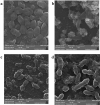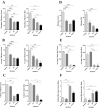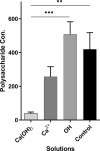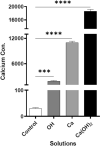Effect of calcium hydroxide on morphology and physicochemical properties of Enterococcus faecalis biofilm
- PMID: 35534609
- PMCID: PMC9085741
- DOI: 10.1038/s41598-022-11780-x
Effect of calcium hydroxide on morphology and physicochemical properties of Enterococcus faecalis biofilm
Abstract
Calcium hydroxide Ca(OH)2 has been used as an intracanal medicament to targets microbial biofilms and avert secondary infection in the root canal system. This study evaluated the effects of this material on the morphology and physicochemical properties of an established in-vitro biofilm of Enterococcus faecalis. A biofilm of E. faecalis was grown in multichannel plates. The chemicals including Ca2+, OH-, and saturated Ca(OH)2 (ie 21.6 mM) were prepared in order to evaluate which component eradicated or amplified biofilm structure. Various biochemical and microscopic methods were used to investigate the properties of the biofilm. Biofilms treated with Ca(OH)2 absorbed more Ca2+ because of the alkaline pH of the environment and the ions affected the physicochemical properties of the E. faecalis biofilm. A denser biofilm with more cavities and a granular surface was observed in the presence of Ca2+ ions. This resulted in a decrease in the surface-to-biofilm ratio with increases in its biomass, thickness, colony size, and volume. Calcium hydroxide did not destroy E. faecalis biofilms but rather contributed to the biofilm structure. This in-vitro study sheds light on a missing link in the formation of E. faecalis biofilm in which the Ca2+ in Ca(OH)2.
© 2022. The Author(s).
Conflict of interest statement
The authors declare no competing interests.
Figures








Similar articles
-
Comparative Evaluation of Antibacterial Efficacy of Silver and Cadmium Nanoparticles and Calcium Hydroxide against Enterococcus faecalis Biofilm.J Contemp Dent Pract. 2021 Dec 1;22(12):1438-1443. J Contemp Dent Pract. 2021. PMID: 35656684
-
Efficacy of chitosan paste as intracanal medication against Enterococcus faecalis and Candida albicans biofilm compared with calcium hydroxide in an in vitro root canal infection model.BMC Oral Health. 2022 Aug 16;22(1):354. doi: 10.1186/s12903-022-02385-x. BMC Oral Health. 2022. PMID: 35974361 Free PMC article.
-
[The effect of a combined nanoparticulate/calcium hydroxide medication on the biofilm of Enterococcus faecalis in starvation phase].Shanghai Kou Qiang Yi Xue. 2016 Feb;25(1):11-5. Shanghai Kou Qiang Yi Xue. 2016. PMID: 27063301 Chinese.
-
Properties and applications of calcium hydroxide in endodontics and dental traumatology.Int Endod J. 2011 Aug;44(8):697-730. doi: 10.1111/j.1365-2591.2011.01886.x. Epub 2011 May 2. Int Endod J. 2011. PMID: 21535021 Review.
-
Antimicrobial Effects of Formulations of Various Nanoparticles and Calcium Hydroxide as Intra-canal Medications Against Enterococcus faecalis: A Systematic Review.Cureus. 2024 Sep 28;16(9):e70382. doi: 10.7759/cureus.70382. eCollection 2024 Sep. Cureus. 2024. PMID: 39469360 Free PMC article. Review.
Cited by
-
Novel approaches on root canal disinfection methods against E. faecalis.J Oral Microbiol. 2025 Mar 6;17(1):2475947. doi: 10.1080/20002297.2025.2475947. eCollection 2025. J Oral Microbiol. 2025. PMID: 40066376 Free PMC article. Review.
-
Management of Enterococcus faecalis associated endodontic infection using gold nanogel: An in-vitro study.Saudi Dent J. 2025 Jul 1;37(4-6):24. doi: 10.1007/s44445-025-00019-w. Saudi Dent J. 2025. PMID: 40593397 Free PMC article.
-
In vitro evaluation of biofilm phenotypic and genotypic characteristics among clinical isolates of Pseudomonas aeruginosa in Hamadan, West of Iran.J Appl Genet. 2024 Feb;65(1):213-222. doi: 10.1007/s13353-023-00811-6. Epub 2023 Nov 28. J Appl Genet. 2024. PMID: 38017355
-
Antibacterial biofilm efficacy of calcium hydroxide loaded on Gum Arabic nanocarrier: an in-vitro study.BMC Oral Health. 2024 Feb 10;24(1):215. doi: 10.1186/s12903-024-03941-3. BMC Oral Health. 2024. PMID: 38341565 Free PMC article.
-
Application of Nanomaterials in Endodontics.BME Front. 2024 Apr 17;5:0043. doi: 10.34133/bmef.0043. eCollection 2024. BME Front. 2024. PMID: 38711803 Free PMC article. Review.
References
-
- Ørstavik D. Endodontic treatment of apical periodontitis. Essen. Endodontol. 2019 doi: 10.1002/9781119272014.ch11. - DOI
-
- Haapasalo M, Endal U, Zandi H, Coil JM. Eradication of endodontic infection by instrumentation and irrigation solutions. Endod. Top. 2005;10:77–102. doi: 10.1111/j.1601-1546.2005.00135.x. - DOI
Publication types
MeSH terms
Substances
LinkOut - more resources
Full Text Sources
Miscellaneous

